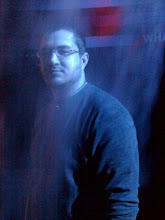Vertov's The Man with a Movie Camera marked a huge change in the way cinema was constructed. Many of the traditional elements of early film and documentary, such as a clear narrative story, are not seen in Vertov's film. What the viewer does experience is a tremendous amount of visual information arranged and composed in new and often very interesting ways. Two aspects of The Man with a Movie Camera that stood out to me are the self-reflexivity seen in the film, and the use of montage to compare and contrast ideas through film imagery.
Vertov is clearly attempting to communicate to anyone who watches the film that he thinks about and plans out each of his shots and their composition. By showing the "man with the movie camera" throughout the film, the audience begins to think about how a film is conceived of and shot, and what goes into the process. The cameraman is seen clearly deciding upon how he wants to shoot his subjects, often running or carefully adjusting his camera to get into good position. In watching the film, I noticed that it actually took me awhile to start thinking about what the shots of the cameraman mean, and even longer to think about the fact that there is actually another camera man shooting and composing what I saw on screen. Vertov seems to be playing with the audiences perception of filmmaking in a way, commenting on the fact that their is indeed a cameraman and editor making decisions about what is to be seen and experienced by the viewer.
Several scenes contain material that seems to advance this idea of the director commenting on himself, his work, and the process of filmmaking in general. Both the beginning and ending of the film feature a theater where a movie is to be viewed. Eventually, the viewer enters that onscreen world along with the audience in the theater. One must consider that they have already entered Vertov's cinematic world by simply watching the film, and that he is adding additional layers of "reality." Also, the idea of documentary as associated with capturing some degree of reality or truth needs to be carefully considered when looking at the film. Many of the shots do seem to be capturing moments, both personal and public, that are largely unaffected by the camera's presence. Every shot that the “cameraman” is in, however, had to be clearly thought out ahead of time and composed by the the cinematographer (likely Vertov). In attempting to capture the “reality” of a man shooting movies with a camera, the film actually takes a step back in terms of portraying actuality on film. This technique truly seems to define the “the creative presentation of actuality.”
In The Man with a Movie Camera, Vertov uses montage during virtually the entire film. Throughout the film he brings together multiple images and film clips, creating meaning through their relationships. The segments of the film that stand out clearly often juxtapose two very different, yet related, ideas. It seems that this is a running theme throughout the film. Vertov explores transportation, contrasting modern avenues such as buses, planes, and cable cars, directly with older types such as steam trains and horse-drawn carriages. Wedding and divorce are explored through both the visuals and the music. Vertov returns to the cable cars to impart even more meaning into this comparison. Themes of life and death are interspersed through the use of footage documenting a funeral procession along with that of a mother going through labor and delivering a baby. Hard work and a variety of occupations are explored before Vertov looks into vacation and a variety of relaxation techniques.
At first, things seemed random and scattered. It was as I began to really concentrate on the images that I was seeing that I started to make some of the connections outlined above. Certainly, Vertov had more goals in mind with the film than simply comparing and contrasting images and ideas, but it seems to me to be the dominate theme behind the film. The director seems to be exploring how film can be used to do many things, but most important how meaning can be formed.
In looking at the notes I took during the film, I focused a lot on the self-reflexivity evident as well as how the montage seems to operate to convey meaning in the piece. I also noticed how Vertov seemed to be continually experimenting, as if this film was his own personal sandbox or toy bin that he was given for the first time and had complete control over. I noted a lot of the techniques that are commonly used in film, video, and television today. We see experiments with camera speed, repetition, extremely fast cutting, slow motion (track and field athletes), eye-line matching (magic show), cutting to action (soccer game), playing film in reverse, dissolves and overlays (cable cars), and many, many more. The Man with a Movie Camera is certainly an “experimental” film that uses montage to address ideas and themes and whose director wishes to communicate his thoughts on filmmaking to an audience, yet it is clearly more than that as well. It seems to be an incredibly important foundational work for not only documentarians, but all future filmmakers.
Thursday, October 22, 2009
Subscribe to:
Post Comments (Atom)

No comments:
Post a Comment